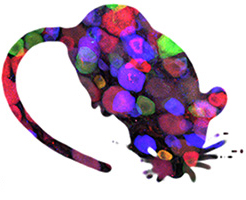
PROFILAGE TRANSCRIPTIONNEL DE NEURONES SENSORIELS ET PHYSIOLOGIE DE LA DOULEUR
Le groupe du Dr A Moqrich (IBDML, Marseille) en collaboration avec l'équipe du Dr Bourinet et la plateforme MGX de l'IGF ont combiné une approche de tri cellulaire suivi de séquençage à haut débit pour identifier le profil transcriptionnel de deux populations de neurones sensoriels (les fibres MRGPRD et les fibres C tactiles C-LTMR) (Reynders et al. Cell Reports, Février 2015, http://dx.doi.org/10.1016/j.celrep.2015.01.022).
Les données ont été validées par un crible d'hybridation in situ et la démonstration que les canaux calciques à bas seuil d'activation codés par la sous unité Cav3.3 sont sélectivement présents et fonctionnels dans les fibres C-LTMR. Ces données confirment le potentiel des canaux calciques de type-T comme cibles de thérapies anti douleur innovantes.
TRANSCRIPTIONAL PROFILING OF SENSORY NEURONS TO UNDERSTAND PAIN PHYSIOLOGY
Dr A Moqrich's group (IBDML, Marseille) in collaboration with Dr E Bourinet's team and the IGF MGX platform combined FACS and RNA deep sequencing to establish the transcriptional profiles of MRGPRD+ free nerve endings and C-LTMRs (Reynders et al. Cell Reports, February 2015, http://dx.doi.org/10.1016/j.celrep.2015.01.022).
They validated their data using an extensive in situ screen and demonstrated that the low threshold calcium channel Cav3.3 channel was exclusively expressed and functionally active in C-LTMRs. This further reinforces the notion that therapeutics targeting T-type calcium channels hold great potential for pain management.





